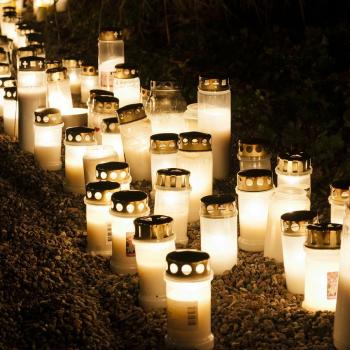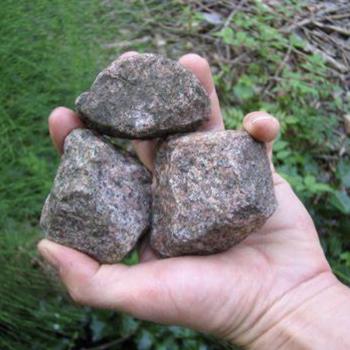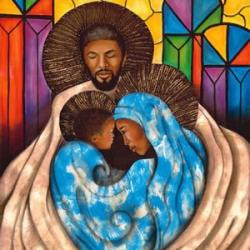We’re celebrating community here at Sick Pilgrim this month, based on the fact that we kick off the month of November by remembering the saints and the souls that make up the great cloud of witnesses who surround us from behind the veil.
As a human person living on this side of heaven, I admit that I have a uniquely–okay, maybe you could even say oddly–Catholic sentiment about keeping saints as friends. I mean, quite honestly, I find them easier to maintain a relationship with than the average living, breathing human. It may seem off-putting to some that I refer to Zelie Martin and Rita of Cascia like they’re girlfriends I meet regularly for coffee, and there are some who would wonder if “Mama Mary” was a grandmotherly figure from my childhood who still looks out for me and takes cares of me from afar.
But if you think my daily coffee talk with the dead is a bit much, wait til I tell you about these relics, which prove that when it comes to the comes the Communion of Saints, we Catholics have absolutely no chill whatsoever.
Relics are, technically, objects remaining that are connected somehow to a saint. Like the way your family might pass down an heirloom of a beloved great-great-grandmother and take meticulous care of it. You get that, right? Totally normal. Totally chill.
We start to lose our chill just a little when we start to classify our relics, though. There are second class relics–clothing or other items used by a saint–okay, we’re still doing all right there. I mean it’s pretty chill to have a gander at St. Therese of Lisieux’s habit in a glass box in front of a side altar in a secret chapel inside the former palace that now holds that Vatican Office for the Congregation of the Evangelization of the Peoples and then kneel down to take your picture with it, right? Relatively speaking? Kind of?
Then there are third class relics, which are objects that have been touched to first class relics–relics of relics, so to speak. This may seem a little less chill to people outside the weirdness of our tradition, but there is nothing particularly odd about kissing a cloth that was touched to what is believed to have maybe been a sliver of the true cross, right? Okay, okay, maybe we are losing our chill just a bit on that one. But we’re still cool about about how not chill we are.
Where the wheels come off the chill wagon are the first class relics–which are literal parts of saints’ bodies–bits of bone, blood, hair, or entire skeletons, and sometimes, whole incorrupt bodies–I’m looking at you John XXIII, with your nose hairs still showing and all. These are presumably acquired in the exhumation that is a required part of the canonization process, or saved by people who knew the living, breathing person who became a saint and were already banking on them earning rank. Like the friar who was St. Maximilian Kolbe’s barber and saved all his beard hairs every time he shaved them, knowing they would be relics some day. Turns out they are the only existing first class relics of St. Maximilian, since his body was incinerated at Auschwitz after his martyrdom. We are all so glad said barber monk had no chill at all about his conviction that Maximilian was a saint. I mean without him, we’d have no tiny lockets full of beard clippings to kiss.
Yep, wheels are off the wagon. The chill is gone. Sing it with me.
Relics are proof that we Catholics, while we try to act cool, actually have no chill whatsoever when it comes to the Communion of Saints. We luuuuurrrrrve our saints so much. We love them so much that we do crazy things sometimes for love them. And we LIKE it.
- Wittoria’s Skeleton in Santa Maria Sopra Minerva Church in Rome:
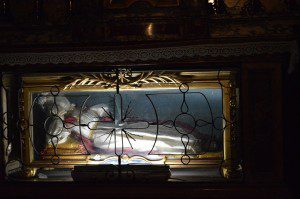
Hello, gorgeous. She’s a catacomb skeleton whose name is a variation of the word “victory.” No one knows her actual story. But apparently they assumed she enjoyed reclining coquettishly upon velvet pillows with her veiled, skeletal head propped up on her elbow. Also, she was fond of floral crowns. How currently chic of her! Someone get this woman a Snapchat account. There are skeletons of this type all over the Catholic world, unknown martyrs removed from the catacombs and put on display to be honored by the faithful. And by honoring them, we mean dressing them up and putting them in positions that are awkward in life, much less in their skeletal version. But, hey, she made it above ground, so there’s that.
- Catherine of Siena’s Head in the Basilica of Saint Dominic in Siena: This may be one of the best–and most un-chill–stories in all of Christendom right here. Catherine was the 23rd of 25 children born to a prominent family in Siena, Italy. Her mission and vocation eventually took her to Rome, where she whipped some popes into shape (but that’s a story for another day), and lived until her death. The Sienese were incensed that their hometown saint would have the audacity to die in Rome and argued to have her body brought home to be buried. Team Rome refused, won the battle, and Catherine of Siena was buried in Rome. But her spiritual director, St. Raymond of Capua, was a Sienese sympathizer, so he arranged to have Catherine’s HEAD, and less consequential but more weird, her left thumb, disengaged from the rest of her body and secretly sent to Siena, proving himself to be one of the least chill of all the no-chill-having, saint-loving Catholics throughout history. And that, kids, is why you can find St. Catherine of Siena’s tomb in Santa Maria sopra Minerva in Rome, and her veiled head, and left thumb, in glass boxes in the Basilica of Saint Dominic in Siena. Sweet dreams!
- Padre Pio’s Heart on Its Jaunt Around the U.S.: St. Padre Pio might be the Church’s most beloved modern saint, and since the man himself had no chill whatsoever about being a saint–bilocation, soul-reading, stigmata, AND an incorrupt body–you can’t expect the Catholics who love him to either. Which is why thousands of them flocked to venerate his heart, which lives outside his incorrupt body, when it left the old shell behind and took a solo jaunt to the U.S. The ‘Merican Catholics got all crunked about getting a little of the beloved Padre on this side of the Atlantic. Bring that heart over here so we can clog it all up with Five Guys and Krispy Kreme. Okay, okay, it doesn’t eat. It just sits around in its glass box while we stare it. And kiss it. And touch things to it. Way more chill. Or not. I don’t even know any more.
- Francis Xavier’s Arm in Church of the Jesu in Rome: Again with the needing to take a saint apart and bring part of him home. Like, how did that go down, really? Were the Jesuits like, “Look, we sent him to Asia, so we should probably let you keep him. But could you just spot us the baptizing arm that he converted a continent with? That’s all we want. We’ll send you more martyrs in exchange”? And to think, all this time, we were ragging on the Jesuits for having too much chill. Nope. Wrong. No chill. At. All. Arm in a box in Rome + Body in Asia = Zero chill.
- Valentine’s Skull in Santa Maria in Cosmedin Church in Rome: Because nothing says romance like a skull without a mandible wearing a fake flower crown! Also, no one really knows IF this is Saint Valentine’s skull and if it is, WHICH of the ten St. Valentines it might have belonged to. But we got a skull in a box with a label on it, so gosh darn it, we’ve got feelings about it. Big ones. See that. Maybe it IS the real St. Valentine after all.
- The Altar of St. Michael’s Basilica in Mondsee, Austria: This altar in the famous church where the wedding scene from The Sound of Music was filmed has so little chill that they had to cover the bejeweled skeletons in its altar piece with statues for the filming of the movie. The world was not ready for our no-chill bedazzling of the bones of martyrs and our use of them as decorations? Hmm. Who would have known?
- Mary Magdalen’s Foot in St. John the Baptist’s Church in Rome:
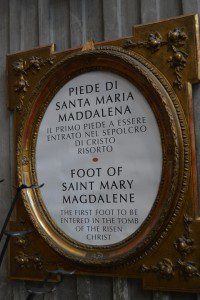
We totally know which foot stepped first into the tomb, okay? Okay, we might need to go ahead and appoint a chill control committee to stop the dismembering of the saints. This relic boasts a sign next to it declaring it “the first foot to enter the tomb of the resurrection.” You might be thinking, “WHEN IT WAS ATTACHED TO A BODY!” But you would be silly. We LIKE just the foot. Much more dramatic. And we totally know which foot she stepped with first. Which is how we modeled this lovely bronze cast so you don’t have to look at the actual foot bones. Because we are so chill. So. Freaking. Chill.
- The Doubting Finger of St. Thomas in the Holy Cross of Jerusalem Church in Rome: Poor Thomas. He did so many other things in his lifetime. I mean, I guess he did. But that finger incident will follow him around for the rest of his eternal life. We just can’t let it die. Which is why we keep it. In a glass box. We buried our chill in an unknown location with the rest of his body. Perhaps it will come back with the next crusade. Oh, wait. Yeah. It’s not coming back.
- John the Baptist’s Head at Amiens Cathedral in France: Apparently it’s not weird enough to simply be the head of a beheaded man. This one has been lost and found on multiple occasions, until, as this article states, it was “restored to its historical glory” by being placed on a silver platter. We are so stealthily ironic, aren’t we? I mean, see what we did there? Also, at one point in history when the French Revolution called for the confiscation of the contents of the Cathedral and the people began to demand the skull be buried, the mayor of the town chose to keep it in his house instead. Bet that made for some interesting dinner party conversation. Super chill, Sir Mayor. Super chill.
- The Capuchin Crypt in the Roman Catacombs: These 3700 skeletons, purportedly Capuchins buried by their brother friars, are in a small area of underground Rome, where they are, in the most chill fashion ever, divided into the Crypt of the Skulls, the Crypt of the Pelvises, and the Crypt of the Leg and Thigh Bones. Look, don’t ask where the rest of the bones are, okay? If the other examples in this list are any indication, they’re probably in lonely glass boxes somewhere. And then there’s the Crypt of the Three Skeletons, where the center skeleton holds a scythe made of bones in one hand, the symbol of death, and a set of scales in the other, a symbol of eternal judgement. Nice, Capuchins. You win the weird relic war. You are the no-chillest of the no-chill Catholics out there. Are any of us really surprised, though? #francis’friends Ahem.
So yeah, if you think we might just be losing it a bit with the saint love, you’re probably right. But the truth is, the relics remind us of two things. First, saints are human beings just like us and we can all strive for the holiness they attained in their lifetimes. And second, there is a limited time in which to do that before you find yourself an awkwardly arranged, dismembered skeleton in a flower crown in a glass box. So we should get to it.
Haloes are for sissies, sickies, let’s make becoming a bedazzled corpse our common goal.
I mean, after eternal life. Obvs.
And then there is this: we firmly believe the souls that belong to these earthly bodies we have bedazzled, dismembered and encased in various styles and fashions are up there, but somehow they know us, they like us, they are on our team, and they want us to join them so much that they are cheering for us with their prayers and intercession. And we’re all pretty sure we aren’t getting there without considerable help, so we’re grateful beyond measure for their generosity.
So grateful, that we lose all our chill when it comes to them.
And nothing says thank you like a velvet pillow to lay your severed skeletal head on and chill, right? No? Well, forgive us then. We got no chill when it comes to our saints.
Colleen C. Mitchell is the author of Who Does He Say You Are? Women Transformed by Christ in the Gospels (Servant, 2016). She’s wife to Greg and mother to five amazing sons here on earth and five babies in heaven. Colleen and Greg are foreign missionaries in Costa Rica, where they run the St. Francis Emmaus Center, a ministry that welcomes indigenous mothers into their home to access medical care. She works out what it means to trust Jesus, grieve well, and live a raw faith at her blog Blessed Are the Feet.



